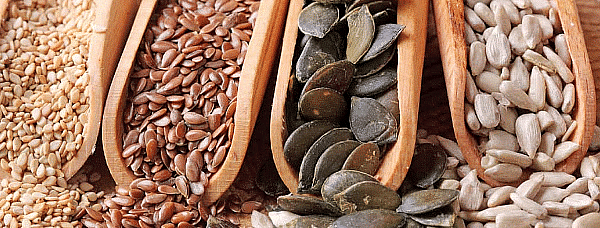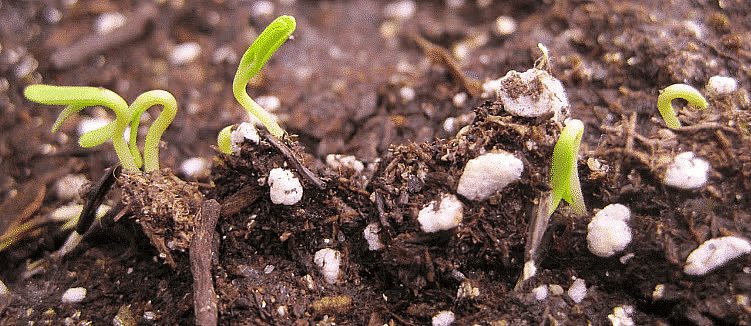Seeds and Seeds - 2 Class 5 Worksheet EVS Chapter 5

Q1: Multiple Choice Questions (MCQs)
(i) Why did Gopal’s mother tie the chana in a damp cloth?
(a) To dry them quickly
(b) To cook them later
(c) To sprout them
(d) To keep them fresh
Ans: (c)
Gopal's mother tied the chana in a damp cloth because it helps the chana get enough moisture to sprout. The cloth provides a humid environment which is ideal for sprouting. Sprouts are often consumed because they are rich in nutrients like proteins, fiber, and vitamins.
(ii) What would happen if the seeds did not get enough water for sprouting?
(a) The seeds will grow faster
(b) The seeds will not sprout
(c) The seeds will rot
(d) The seeds will turn into powder
Ans: (b)
Seeds need the right amount of water to sprout. Without enough water, they remain dry and do not activate the enzymes required for sprouting. The water softens the seed coat and provides the energy needed for the growth of the seedling.
(iii) What did Gopal's mother do with the extra soaked chana?
(a) She cooked them all.
(b) She sent half of them to Gopal's aunt for sprouting.
(c) She fed them to the birds.
(d) She stored them for later use.
Ans: (b)
Gopal's mother sent half of the soaked chana to his aunt for sprouting, as per the doctor's recommendation.
(iv) Which of the following is a benefit of eating sprouts?
(a) Sprouts are difficult to digest
(b) Sprouts are low in nutrients.
(c) Sprouts are rich in vitamins and proteins
(d) Sprouts taste bitter
Ans: (c)
Sprouts are highly nutritious and provide a great source of vitamins, minerals, proteins, and fibers. They are easy to digest and are often included in diets for their health benefits.
Q2: Fill in the Blanks
(i) Gopal was waiting for his ___________ family to visit them.
Ans: Mausi's
(ii) Gopal's mother asked him to soak two small bowls of ___________ before sleeping.
Ans: chana (gram)
(iii) Gopal soaked ___________ more bowls of chana as he thought two bowls would not be enough.
Ans: two
(iv) Gopal's mother decided to cook half of the soaked chana and leave the other half to ___________.
Ans: sprout
(v) The doctor advised Gopal's aunt to eat ___________.
Ans: sprouts
Q3: Match the Column
Ans:
Q4: True or False
(i) Seeds can also travel by sticking to clothes or animal fur. (True/False)Ans: True
(ii) Potatoes and tomatoes were always grown in India since ancient times. (True/False)
Ans: False
(iii) Mangoes and bananas were grown in India long ago. (True/False)
Ans: False

Q4: Short & Long Answer Type Questions
(i) Describe the process of seed sprouting and what are the requirements for successful sprouting?Ans: Seed sprouting is the process where a seed begins to grow into a new plant. The requirements for successful sprouting are air, water, and soil. The seed absorbs water, and with the help of air and nutrients from the soil, it starts to germinate. The radicle emerges first, followed by the shoot, and eventually, the seedling emerges from the soil.
(ii) Explain the different ways seeds are spread to far-off places.
Ans: Seeds are spread to far-off places through various means. Some seeds have structures that allow them to be carried by the wind (e.g., flying seeds), while others have hooks or sticky surfaces that attach to animals' fur or human clothes, allowing them to travel to different locations. Some seeds are dispersed through explosive mechanisms like bursting pods. Humans also play a significant role in seed dispersal, knowingly or unknowingly, by carrying seeds to different regions.
(iii) Research and write about some plants that have unique ways of dispersing their seeds.
Ans: Research and write about some plants that have unique ways of seed dispersal. Some examples could be coconut trees that have buoyant seeds that can travel through water, burr-bearing plants that have seeds with hooked structures that stick to animals, and squirting cucumber plants that have fruits that forcefully eject their seeds when they ripen.
(iv) How did George Mestral get the idea of making Velcro?
Ans: George Mestral got the idea of making Velcro after observing seeds under a microscope. He saw that the seeds had tiny hooks that stuck to clothes and fur, which inspired him to create a material with similar tiny hooks for sticking.
(v) How do humans spread seeds to different places?
Ans: Humans spread seeds to different places knowingly or unknowingly. They bring seeds of plants they find beautiful or useful to grow them in their gardens. Later, the seeds of these plants spread to other places.
|
37 videos|244 docs|41 tests
|
FAQs on Seeds and Seeds - 2 Class 5 Worksheet EVS Chapter 5
| 1. What are seeds? |  |
| 2. How do seeds germinate? |  |
| 3. What factors affect seed germination? |  |
| 4. How long does it take for seeds to germinate? |  |
| 5. Can all seeds germinate? |  |
















